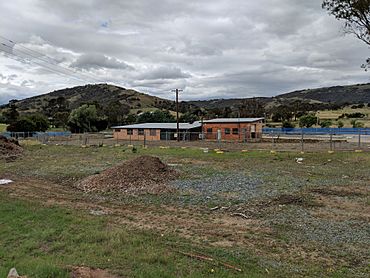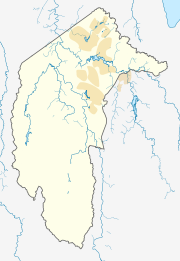Williamsdale, Australian Capital Territory facts for kids
Quick facts for kids WilliamsdaleAustralian Capital Territory |
|||||||||||||||
|---|---|---|---|---|---|---|---|---|---|---|---|---|---|---|---|

Abandoned garage in Williamsdale
|
|||||||||||||||
| Population | 43 (2021 census) | ||||||||||||||
| Location | 35 km (22 mi) S of Canberra | ||||||||||||||
| District | Tuggeranong | ||||||||||||||
| Territory electorate(s) | Brindabella | ||||||||||||||
| Federal Division(s) | Bean | ||||||||||||||
|
|||||||||||||||
Williamsdale is a small town in Australia, located in the Australian Capital Territory (ACT). It sits right on the border with New South Wales (NSW), next to another town also called Williamsdale! The main road, the Monaro Highway, goes through Williamsdale. There used to be a train line here too, with a station that closed in 1975. The postcode for Williamsdale is 2620.
Contents
What is Williamsdale Like?
The part of Williamsdale in the ACT is included in a larger area called "Tuggeranong (SA2)" by the Australian Bureau of Statistics. This area also includes parts of Royalla and other rural land.
How Many People Live Here?
In 2021, only 43 people lived in the ACT part of Williamsdale. The part of Williamsdale in NSW had 65 people living there at the same time.
Local Government Areas
The Williamsdale area in NSW is divided between two different local councils. The northern part belongs to the Queanbeyan–Palerang Regional Council. The southern part belongs to the Snowy Monaro Regional Council.
Rocks and Land Around Williamsdale
The land around Williamsdale has some interesting rock formations. These rocks tell us about the Earth's history in this area.
Williamsdale Volcanics
East of Williamsdale, you can find rocks called the Williamsdale Volcanics. These rocks are made of a blue-green material called crystal tuff. Imagine tiny crystals, about the size of a grain of sand, mixed into a fine rock. These crystals are mostly quartz, with some other minerals like feldspar and biotite.
Colinton Volcanics
Underneath Williamsdale, there are older rocks from the Middle Silurian period. These are called Colinton Volcanics. They are made of dacite and tuff, which are types of volcanic rock. These rocks stretch north along the Monaro Highway and south past towns like Michelago and Bredbo.
Laidlaw Volcanics
To the west of Williamsdale, you can see dark grey rocks called Upper Silurian Laidlaw Volcanics. These are also crystal tuff, formed from volcanic ash. This type of rock can be found stretching all the way to Mount Stromlo in the north.
Bransby Beds
Near the Murrumbidgee River, on its west side, are the Bransby Beds (sometimes called Goosoon Beds). These layers of rock contain tuff, dacite, and some sediments. They form a narrow band that goes south along the east side of the Murrumbidgee River, reaching as far as Cooma.
Plans for an Airport
Years ago, in 2005, there was an idea to build a new airport near Williamsdale. This airport would have been just for smaller planes, not big passenger jets. It was suggested because it was becoming more expensive for small planes to use Canberra Airport.
Why a New Airport?
The plan was to build hangars (places to store planes), maintenance areas, fuel stations, and a 1000-meter long grass runway. A study was done in 2010 to see if it was a good idea. The study found that while many people wanted such a facility, it might not make much money compared to how much it would cost to build.
What Happened to the Plan?
By 2012, the ACT government decided not to build the airport themselves. However, they made the study results public. This means that if a private company wanted to build the airport, they could use this information to help them decide.
Williamsdale Solar Farm
Williamsdale is home to a large solar farm! This is a special place where sunlight is turned into electricity.
How the Solar Farm Started
In 2012, a company called ActewAGL got permission to build a big electricity plant using solar panels. It was planned to cover about 45 hectares (that's like 110 football fields!) and have 15 groups of solar panels. It was designed to produce 20 megawatts of power. The land for the solar farm was bought in 2009.
Building the Solar Farm
Later, the project was made a bit smaller, aiming to produce 11.8 megawatts. The plan was approved in January 2016. The company that owned the project, Elementus Energy, sold it to another group. A German company, ib vogt GmbH, was hired to build it. The very first solar panel was put in place in October 2016. The whole construction was finished in October 2017. This solar farm is special because its panels can actually follow the sun as it moves across the sky, making sure they catch as much sunlight as possible!



